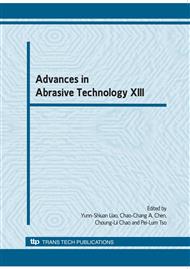p.463
p.469
p.475
p.481
p.487
p.493
p.499
p.505
p.511
Identification of Brittle-Ductile Material Removal Characteristics in Ultrasonic Aided Lapping of Engineering Ceramics
Abstract:
For the precision engineering ceramics parts, semi-ductile regime machining technologies are usually adopted to obtain the final surface. It is very important to research the brittle-ductile material removal characteristics and corresponding monitoring technology in ultrasonic aided lapping of engineering ceramics to obtain better surface quality. A series of lapping tests were carried out in the paper and the influence law of lapping parameters on the ductile percentage of ultrasonic lapped surface was achieved, which enables to off-line identify the material removal characteristics. Though the material removal characteristics can be online judged through monitoring the ratio of lapping component forces qualitatively, the monitoring effect is worse just because of lower response frequency of dynamometer and the relativity of lapping force. In this paper, a novel online monitoring technology of material removal characteristics is put forward based on AE technology. Through the wavelet package analysis of AE signals, the discrimination index and standard of material removal characteristics can be obtained. It is proved that this technology can realize online identification of the brittle-ductile material removal characteristics in ultrasonic aided lapping of engineering ceramics effectively.
Info:
Periodical:
Pages:
487-492
Citation:
Online since:
August 2010
Authors:
Price:
Сopyright:
© 2010 Trans Tech Publications Ltd. All Rights Reserved
Share:
Citation:


